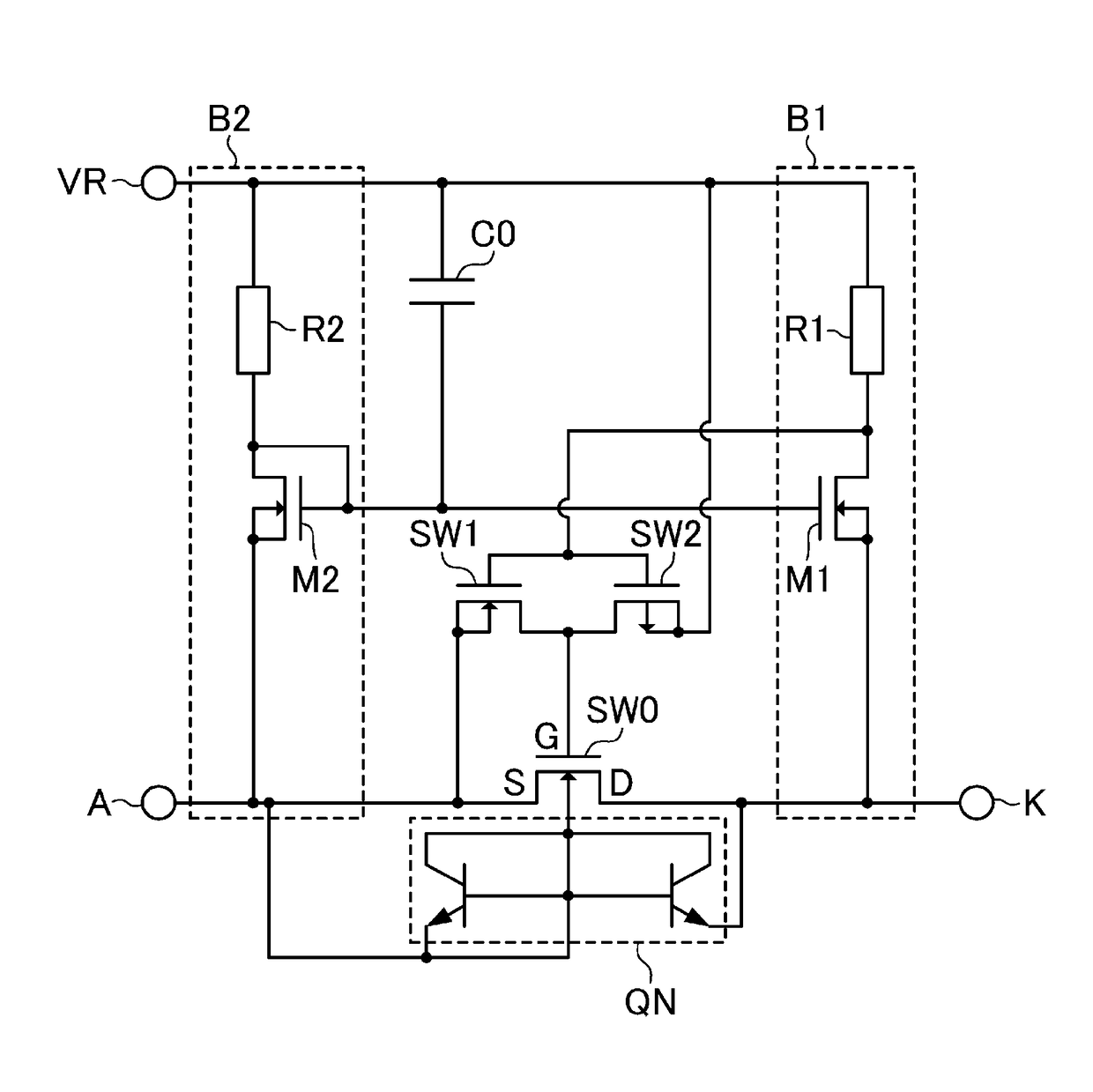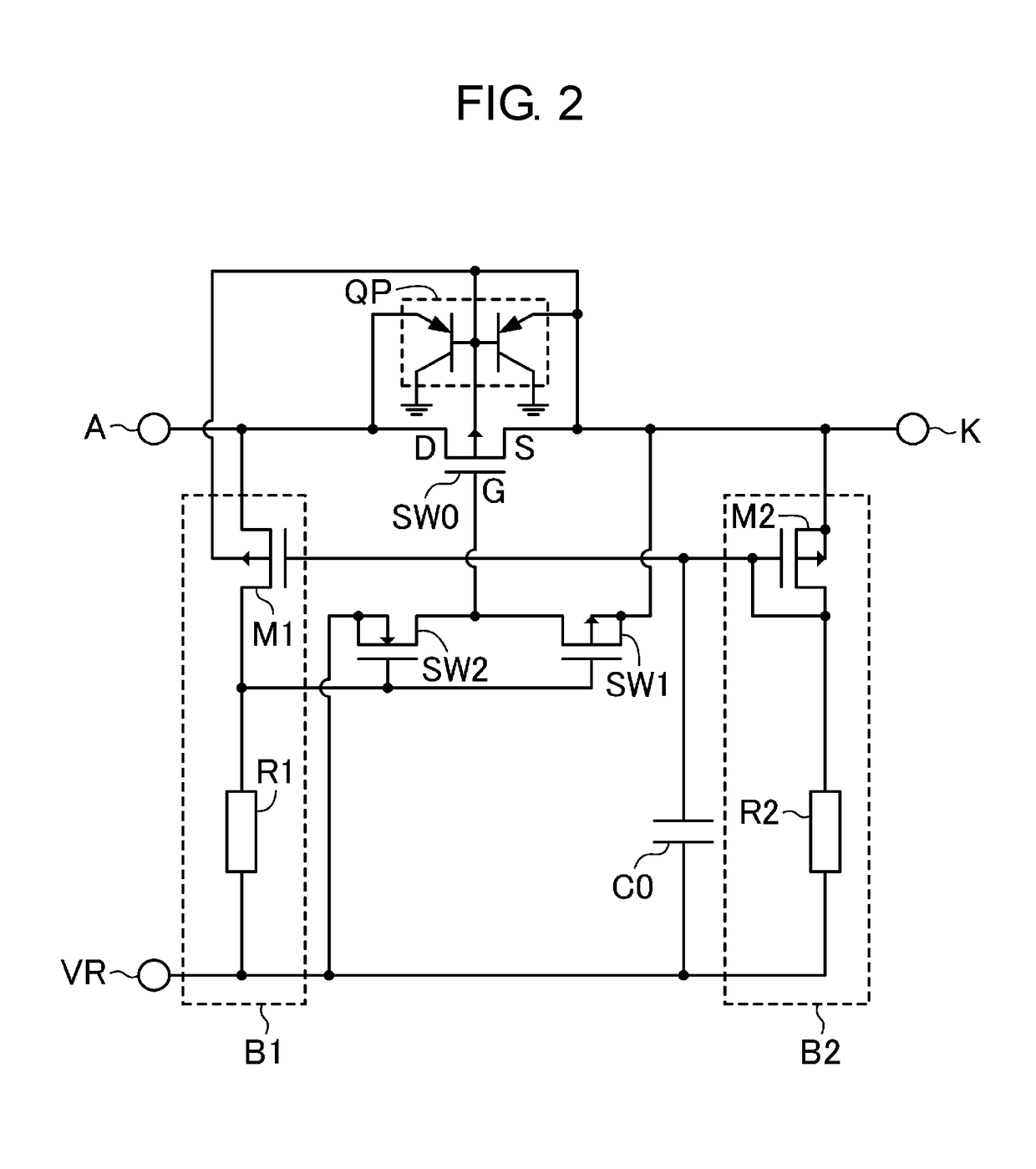Rectifier circuit, and contactless power supply device
a technology of rectifier circuit and contactless power supply, which is applied in the direction of electric variable regulation, process and machine control, instruments, etc., can solve the problems of increasing power consumption and power loss of vtpid, and achieve the effect of improving power supply capability and low power loss
- Summary
- Abstract
- Description
- Claims
- Application Information
AI Technical Summary
Benefits of technology
Problems solved by technology
Method used
Image
Examples
first exemplary embodiment
[0037]FIG. 1 illustrates an example configuration of a rectifier circuit according to a first exemplary embodiment of the present disclosure. The rectifier circuit of FIG. 1 includes three terminals A, K, VR and is formed of N-channel MOS transistor SW0 as a current switching unit, voltage comparator B1, and reference voltage generator B2. N-channel MOS transistor SW1 operating as a switch is connected between a source and a gate of N-channel MOS transistor SW0. P-channel MOS transistor SW2 operating as a switch is connected between the gate of N-channel MOS transistor SW0 and terminal VR. N-channel MOS transistor SW0 is formed on a triple well, with a back gate connected to the source and to an N-well substrate. QN indicates a parasitic bipolar transistor incorporated inside N-channel MOS transistor SW0.
[0038]Reference voltage generator B2 is formed of N-channel MOS transistor M2 in which a gate and a drain are commonly connected, and resistor R2. Resistor R2 is connected between t...
second exemplary embodiment
[0042]FIG. 2 illustrates an example configuration of a rectifier circuit according to a second exemplary embodiment of the present disclosure. The rectifier circuit of FIG. 2 includes three terminals A, K, VR, and is formed of P-channel MOS transistor SW0 as a current switching unit, voltage comparator B1, and reference voltage generator B2. P-channel MOS transistor SW1 operating as a switch is connected between a source and a gate of P-channel MOS transistor SW0, and N-channel MOS transistor SW2 operating as a switch is connected between the gate of P-channel MOS transistor SW0 and terminal VR. A back gate of P-channel MOS transistor SW0 is connected to the source. QP indicates a parasitic bipolar transistor incorporated inside P-channel MOS transistor SW0.
[0043]Reference voltage generator B2 is formed of P-channel MOS transistor M2 in which a gate and a drain are commonly connected, and resistor R2. Resistor R2 is connected between terminal VII and the drain of P-channel MOS trans...
third exemplary embodiment
[0047]FIG. 3 illustrates an example configuration of a rectifier circuit according to a third exemplary embodiment of the present disclosure. In the rectifier circuit of FIG. 3, resistor R1 and resistor R2, which are used in the rectifier circuit of FIG. 1, are respectively replaced with P-channel MOS transistors M3 and M4 each operating as a constant current source. The rectifier circuit of FIG. 3 differs from the rectifier circuit of FIG. 1 in that: a drain and a source of N-channel MOS transistor SW4 are respectively connected to a source and a back gate of N-channel MOS transistor SW0; a drain and a source of N-channel MOS transistor SW3 are respectively connected to a drain and the back gate of N-channel MOS transistor SW0; an N-well substrate of N-channel MOS transistor SW0 formed on a triple well is connected to terminal VR; a gate of N-channel MOS transistor SW0 is connected to a gate of N-channel MOS transistor SW3; and a comparative output terminal of voltage comparator B1...
PUM
 Login to View More
Login to View More Abstract
Description
Claims
Application Information
 Login to View More
Login to View More - R&D
- Intellectual Property
- Life Sciences
- Materials
- Tech Scout
- Unparalleled Data Quality
- Higher Quality Content
- 60% Fewer Hallucinations
Browse by: Latest US Patents, China's latest patents, Technical Efficacy Thesaurus, Application Domain, Technology Topic, Popular Technical Reports.
© 2025 PatSnap. All rights reserved.Legal|Privacy policy|Modern Slavery Act Transparency Statement|Sitemap|About US| Contact US: help@patsnap.com



